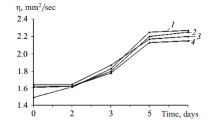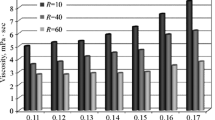The sol-gel method was used to synthesize thin films based on the system SiO2–CaO–P2O5–TiO2. Infrared spectroscopy, x-ray phase analysis, and thermal analysis were used to investigate the properties of the material. The thin films were obtained from film-forming solutions (FFS) on substrates comprised of single-crystalline silicon (model substrate) by drawing at the rate 5 mm/sec followed by heat-treatment at 60°C for 20 min and at 600 and 800°C for 1 h. The biological activity was investigated under artificial conditions in the SBF medium. Bioactive material starts to grow when the weight content of titanium oxide in the system reaches 10%.







Similar content being viewed by others
References
M. Jokinen and H. Rahial, Relation between aggregation and heterogeneity of obtained structure in sol-gel derived CaO–P 2 O 5 –SiO 2 , Kluwer Academic Publishers (1998), pp. 159 – 167.
H. Li and J. Chang, “Stimulation of proangiogenesis by calcium silicate bioactive ceramic,” Acta Biomater., No. 9, 5379 – 5389 (2013).
J. Zhang, W. Liu, V. Schnitzler, and F. Tancret, “Calcium phosphate cements for bone substitution: Chemistry, handling and mechanical properties,” Acta Biomater., No. 10, 1035 – 1039 (2014).
N. Letaïef, A. Lucas-Girot, H. Oudadesse, et al., “Investigation of the surfactant type effect on characteristics and bioactivity of new mesoporous bioactive glass in the ternary system SiO2–CaO–P2O5: Structural, textural and reactivity studies,” Acta Biomater., No. 195, 109 – 111 (2014).
S. V. Dorozhkin, “Bioceramics based on calcium orthophosphate,” Steklo Keram., No. 12, 26 – 31 (2007); S. V. Dorozhkin, “Bioceramics based on calcium orthophosphate,” Glass Ceram., 64(11 – 12), 442 – 447 (2007).
N. M. Shaluho, M. I. Kuzmenkov, and I. A. Bogdanovich, “Materials for dental prosthesis,” Glass Ceram., 69(7 – 8), 243 – 245 (2012).
Q. Wang, H. Hu, Y. Qiao, et al., “Synthesis and in vitro bioactivity of CaO–SiO2–P2O5 mesoporous microspheres,” Micropor. Mesopor. Mater., No. 135, 67 – 78 (2010).
S. Sibte, A. Abidi, and Q. Murtaza, “Synthesis and characterization of nano-hydroxyapatite powder using wet chemical precipitation reaction,” J. Mater. Sci. Technol., No. 30, 307 – 310 (2014).
L. Hench, “Bioglass and similar materials,” in: Encyclopedia of Materials: Science and Technology, pp. 563 – 568.
Y. Castro, J. Mosa, and M. Aparicio, “Sol-gel hybrid membranes loaded with meso/macroporous SiO2, TiO2–P2O5 and SiO2–TiO2–P2O5 materials with high proton conductivity,” Mater. Chem. Phys., No. 149 – 150, 686 – 694 (2015).
A. N. Belov, I.M. Gavrilin, S. A. Gavrilov, A. A. Dronov, “Specific features of the morphology of titanium oxide films prepared by pulling silicon substrates from a solution,” Microelectron. Technol., 45(13), 653 – 1655 (2011).
L. P. Borilo, T. S. Petrovskaya, E. S. Lyutova, and L. N. Spivakova, “Synthesis and physico-chemical properties of thin-film and disperse functional silico-phosphate materials,” Izv. Tomsk. Poltekhn. Univer., Khim., 319(3), 41 – 47 (2011).
T. S. Petrovskaya, L. P. Borilo, V. I. Vereshchagin, and V. V. Kozik, “Structure and properties of nanoproducts of the systems SiO2–P2O5,” Steklo Keram., No. 11, 29 – 31 (2008); T. S. Petrovskaya, L. P. Borilo, V. I. Vereshchagin, and V. V. Kozik, “Structure and properties of nanoproducts of the systems SiO2–P2O5,” Glass Ceram., 65(11 – 12), 410 – 414 (2008).
L. P. Borilo, T. S. Petrovskaya, and E. S. Lyutova, “Synthesis and properties of thin films based on phases in the system SiO2–P2O5–CaO,” Neorg. Mater., 50, 874 – 877 (2014).
Y. Qiao, Z. Zhang, and Sun, “Enhanced performance of osteoblasts by silicon incorporated porous TiO2 coating,” J. Mater. Sci. Technol., No. 28, 109 – 117 (2012).
M. Bianchi, E. R. Urquia Edreira, G. C. Wolke Joop, et al., “Substrate geometry directs the in vitro mineralization of calcium phosphate ceramics,” Acta Biomater., No. 10, 661 – 669 (2014).
S. Sibte, A. Abidi, and Q. Murtaza, “Synthesis and characterization of nanohydroxyapatite powder using wet chemical precipitation reaction,” J. Mater. Sci. Technol., No. 30, 307 – 310 (2014).
O. Peitl, E. Zanotto, F. Serbena, and L. Hench, “Compositional and microstructural design of highly bioactive P2O5–Na2O–CaO–SiO2 glass-ceramics,” Acta Biomater., No. 8, 321 – 332 (2012).
This work was performed as part of a government task (government registration No. 114051370021) of the Ministry of Science and Education of the Russian Federation under contract No. 1432.
Author information
Authors and Affiliations
Corresponding author
Additional information
Translated from Steklo i Keramika, No. 9, pp. 39 – 44, September, 2016.
Rights and permissions
About this article
Cite this article
Borilo, L.P., Lyutova, E.S. Properties of Materials Obtained by the Sol-Gel Method Based on the System SiO2–CaO–P2O5–TiO2 . Glass Ceram 73, 348–352 (2017). https://doi.org/10.1007/s10717-017-9887-2
Published:
Issue Date:
DOI: https://doi.org/10.1007/s10717-017-9887-2




